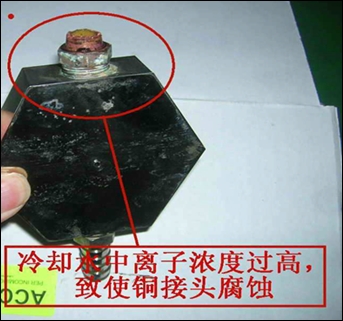- 14
- Apr
Importanța apei circulante în cuptorul de topire a metalelor
Importanța apei circulante în cuptorul de topire a metalelor
In most metal smelting furnaces, the furnace body and the power cabinet have two independent water systems, an internal circulation system, an external circulation system, internal closed-circuit deionized water, and include a water-to-water heat exchanger, rectification Silicon, reactors, filter capacitors, inverter silicon, and resonance capacitors are all connected to this system. Since the internal water system circulates in the DC high voltage, the internal cooling water will generate electric ions under the action of the pipeline DC high voltage. After a period of time, the concentration of electric ions will gradually increase. When the concentration of electric ions exceeds the required value, the high DC voltage will corrode the copper joints through the cooling water with high concentration of ions, resulting in the situation seen in the photo below. If the water connector corrodes and breaks during use of the power supply, the pressurized cooling water will spray out, causing major equipment accidents, and the cooling water with high concentration of electric ions will reduce the insulation of the system, which is more likely to cause damage to the thyristor Therefore, the conductivity of the cooling water should be checked regularly, and it must be less than 10us/cm. If the conductivity is greater than 100us/cm, replace the circulating cooling water in all power cabinets, and it is recommended to replace it every six months.

Există o altă problemă în utilizarea răcirii cu apă închisă la care ar trebui să se acorde atenție. Sistemul de răcire a apei trebuie să fie echipat cu o supapă de evacuare. Cu toate acestea, în utilizarea reală, majoritatea sistemelor de răcire a apei fără supapă de evacuare sunt instalate. Când cuptorul nu mai funcționează mult timp, gazul este ușor de pătruns în separatorul de apă. Când repornirea cuptorului de topire a metalului, o parte din gaz va rămâne în separatorul de apă și în cutia de apă de răcire a componentelor și nu poate fi descărcată, rezultând defectarea acestei componente. Răcirea apei circulante face ca temperatura să fie prea mare pentru a arde componentele. Prin urmare, sistemul de răcire a apei fără supapă de scurgere nu este utilizat mult timp și este activat din nou. Clema de apă din cel mai înalt punct al separatorului de apă trebuie slăbită pentru a scurge gazul rămas.
